Biomedicine Cell Module Short Answer Questions
VerifiedAdded on 2023/06/08
|11
|1577
|202
AI Summary
This article contains short answer questions on Biomedicine Cell Module covering topics like amino acid structure, protein chain, quaternary structure, mitochondria, chloroplast, cell differentiation, extracellular matrix, neoplasms, haemocytometer grid, cell culture and temperature effects.
Contribute Materials
Your contribution can guide someone’s learning journey. Share your
documents today.

Answer the questions appropriately. Your answer should be in red
or highlight the appropriate answer in red.
Section A
Answer ALL short questions in the spaces provided.
1. Identify the alpha carbon molecule in the amino acid structure
below.
Ans: carbon no. 2
(Total 2 Marks)
2. The primary sequence of a peptide is shown below:
ALIPFQVWGC
(a) Which amino acid is present at the carboxyl terminus of the
peptide? Ans: Cystenine amino acid
(2 Marks)
(b) Complete the sentence:
The amino acids in this peptide sequence predominantly
have ___Nonpolar____________ side-chains.
(i) Basic
or highlight the appropriate answer in red.
Section A
Answer ALL short questions in the spaces provided.
1. Identify the alpha carbon molecule in the amino acid structure
below.
Ans: carbon no. 2
(Total 2 Marks)
2. The primary sequence of a peptide is shown below:
ALIPFQVWGC
(a) Which amino acid is present at the carboxyl terminus of the
peptide? Ans: Cystenine amino acid
(2 Marks)
(b) Complete the sentence:
The amino acids in this peptide sequence predominantly
have ___Nonpolar____________ side-chains.
(i) Basic
Secure Best Marks with AI Grader
Need help grading? Try our AI Grader for instant feedback on your assignments.
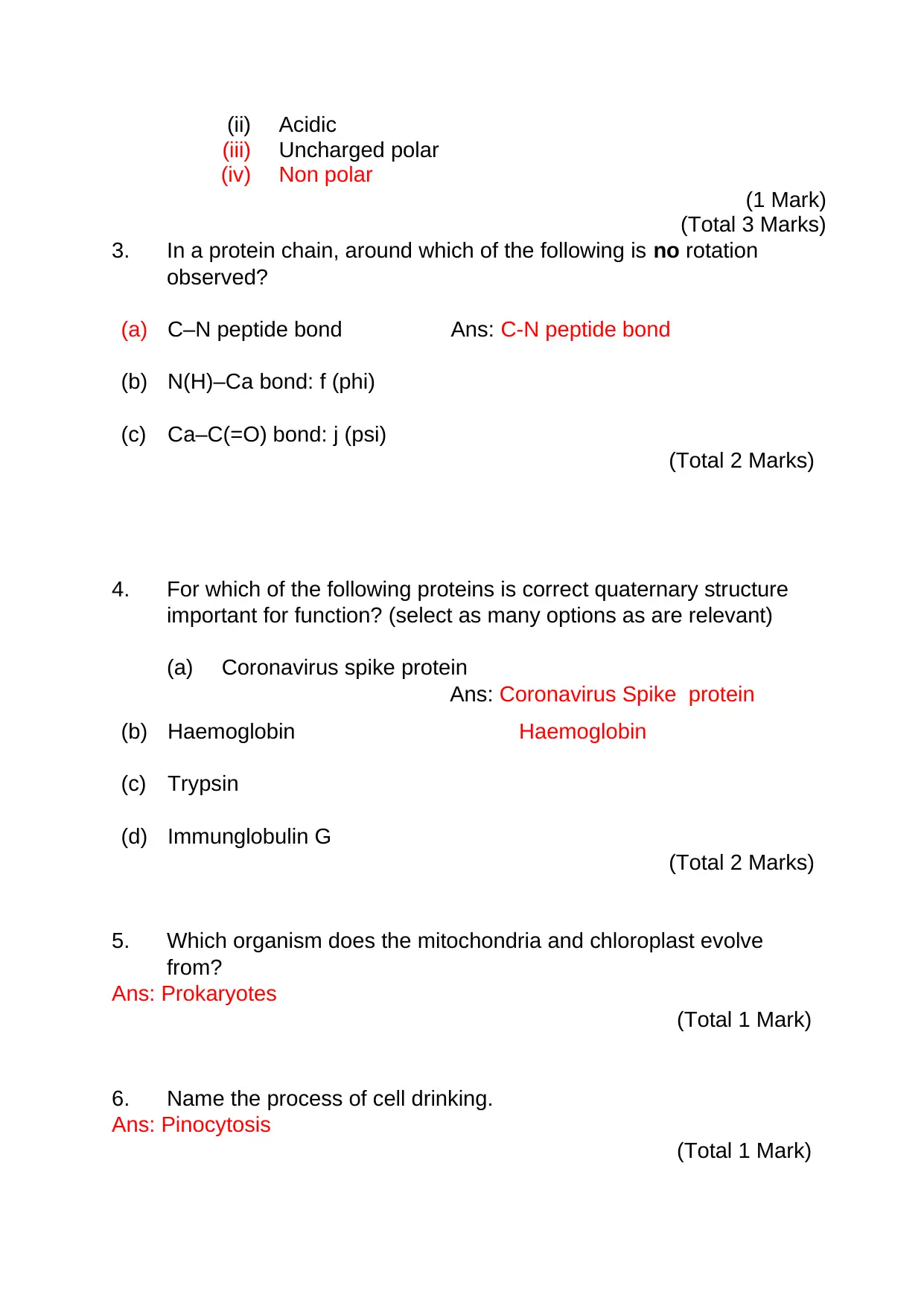
(ii) Acidic
(iii) Uncharged polar
(iv) Non polar
(1 Mark)
(Total 3 Marks)
3. In a protein chain, around which of the following is no rotation
observed?
(a) C‒N peptide bond Ans: C-N peptide bond
(b) N(H)‒Ca bond: f (phi)
(c) Ca‒C(=O) bond: j (psi)
(Total 2 Marks)
4. For which of the following proteins is correct quaternary structure
important for function? (select as many options as are relevant)
(a) Coronavirus spike protein
Ans: Coronavirus Spike protein
(b) Haemoglobin Haemoglobin
(c) Trypsin
(d) Immunglobulin G
(Total 2 Marks)
5. Which organism does the mitochondria and chloroplast evolve
from?
Ans: Prokaryotes
(Total 1 Mark)
6. Name the process of cell drinking.
Ans: Pinocytosis
(Total 1 Mark)
(iii) Uncharged polar
(iv) Non polar
(1 Mark)
(Total 3 Marks)
3. In a protein chain, around which of the following is no rotation
observed?
(a) C‒N peptide bond Ans: C-N peptide bond
(b) N(H)‒Ca bond: f (phi)
(c) Ca‒C(=O) bond: j (psi)
(Total 2 Marks)
4. For which of the following proteins is correct quaternary structure
important for function? (select as many options as are relevant)
(a) Coronavirus spike protein
Ans: Coronavirus Spike protein
(b) Haemoglobin Haemoglobin
(c) Trypsin
(d) Immunglobulin G
(Total 2 Marks)
5. Which organism does the mitochondria and chloroplast evolve
from?
Ans: Prokaryotes
(Total 1 Mark)
6. Name the process of cell drinking.
Ans: Pinocytosis
(Total 1 Mark)
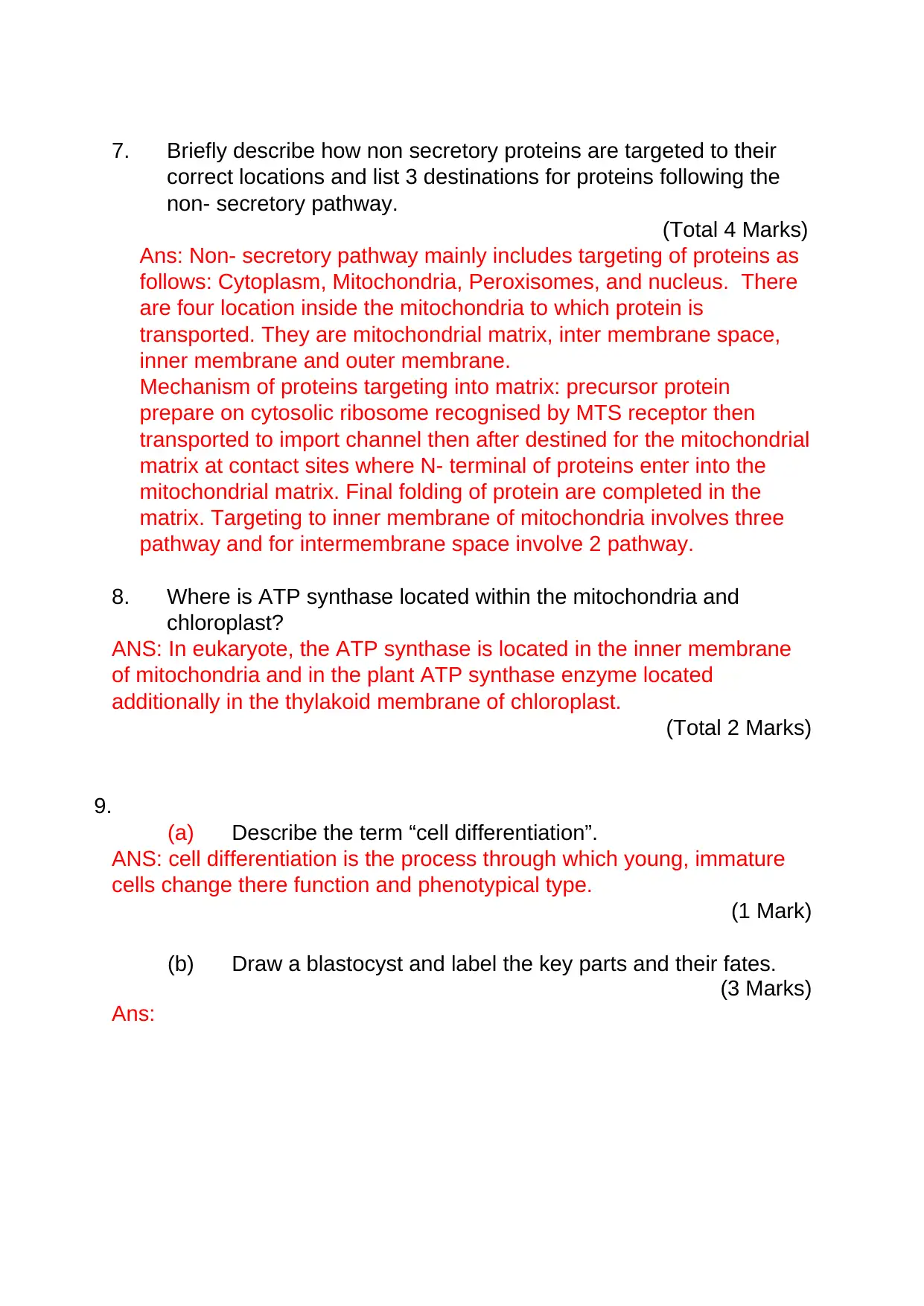
7. Briefly describe how non secretory proteins are targeted to their
correct locations and list 3 destinations for proteins following the
non- secretory pathway.
(Total 4 Marks)
Ans: Non- secretory pathway mainly includes targeting of proteins as
follows: Cytoplasm, Mitochondria, Peroxisomes, and nucleus. There
are four location inside the mitochondria to which protein is
transported. They are mitochondrial matrix, inter membrane space,
inner membrane and outer membrane.
Mechanism of proteins targeting into matrix: precursor protein
prepare on cytosolic ribosome recognised by MTS receptor then
transported to import channel then after destined for the mitochondrial
matrix at contact sites where N- terminal of proteins enter into the
mitochondrial matrix. Final folding of protein are completed in the
matrix. Targeting to inner membrane of mitochondria involves three
pathway and for intermembrane space involve 2 pathway.
8. Where is ATP synthase located within the mitochondria and
chloroplast?
ANS: In eukaryote, the ATP synthase is located in the inner membrane
of mitochondria and in the plant ATP synthase enzyme located
additionally in the thylakoid membrane of chloroplast.
(Total 2 Marks)
9.
(a) Describe the term “cell differentiation”.
ANS: cell differentiation is the process through which young, immature
cells change there function and phenotypical type.
(1 Mark)
(b) Draw a blastocyst and label the key parts and their fates.
(3 Marks)
Ans:
correct locations and list 3 destinations for proteins following the
non- secretory pathway.
(Total 4 Marks)
Ans: Non- secretory pathway mainly includes targeting of proteins as
follows: Cytoplasm, Mitochondria, Peroxisomes, and nucleus. There
are four location inside the mitochondria to which protein is
transported. They are mitochondrial matrix, inter membrane space,
inner membrane and outer membrane.
Mechanism of proteins targeting into matrix: precursor protein
prepare on cytosolic ribosome recognised by MTS receptor then
transported to import channel then after destined for the mitochondrial
matrix at contact sites where N- terminal of proteins enter into the
mitochondrial matrix. Final folding of protein are completed in the
matrix. Targeting to inner membrane of mitochondria involves three
pathway and for intermembrane space involve 2 pathway.
8. Where is ATP synthase located within the mitochondria and
chloroplast?
ANS: In eukaryote, the ATP synthase is located in the inner membrane
of mitochondria and in the plant ATP synthase enzyme located
additionally in the thylakoid membrane of chloroplast.
(Total 2 Marks)
9.
(a) Describe the term “cell differentiation”.
ANS: cell differentiation is the process through which young, immature
cells change there function and phenotypical type.
(1 Mark)
(b) Draw a blastocyst and label the key parts and their fates.
(3 Marks)
Ans:
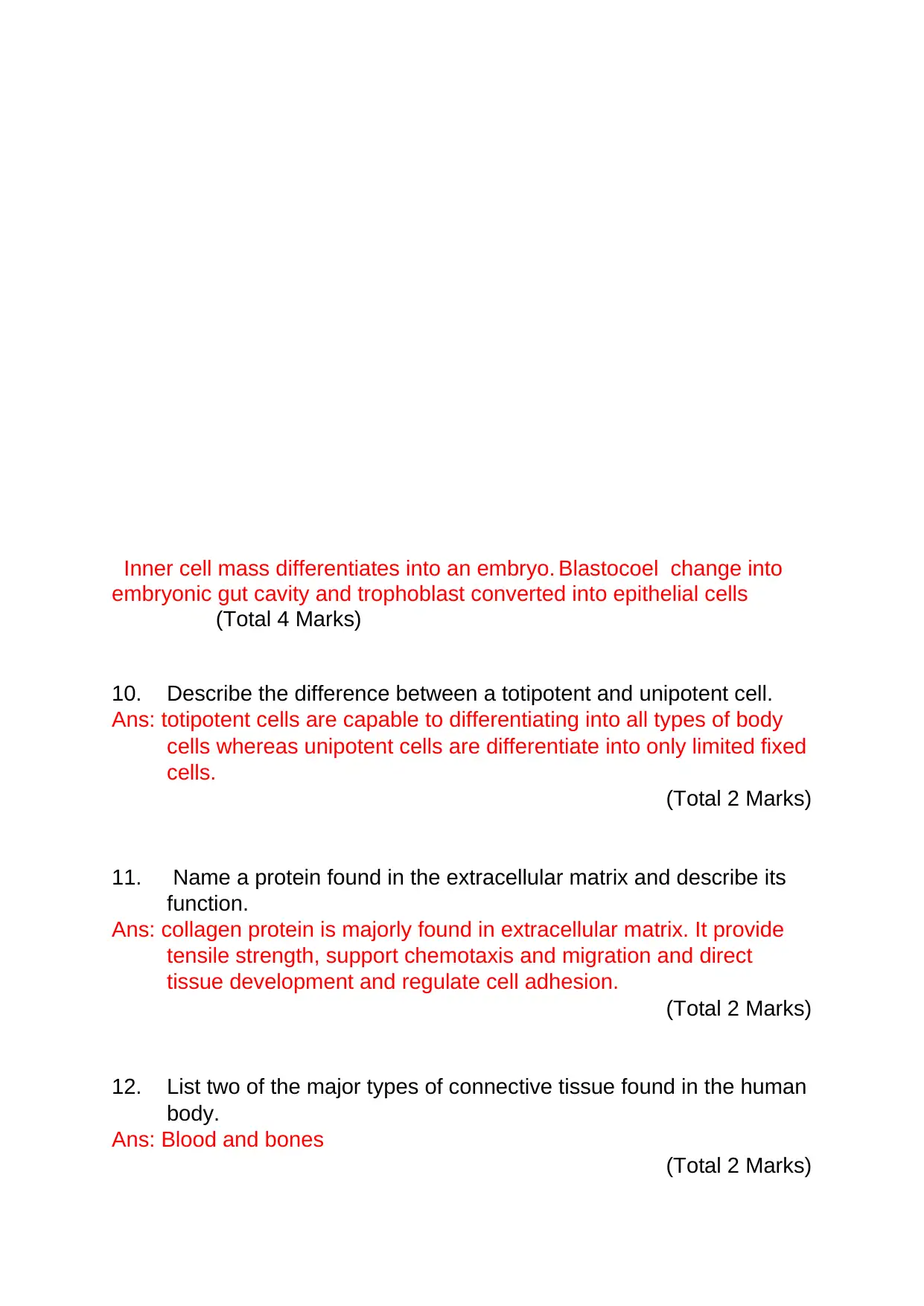
Inner cell mass differentiates into an embryo. Blastocoel change into
embryonic gut cavity and trophoblast converted into epithelial cells
(Total 4 Marks)
10. Describe the difference between a totipotent and unipotent cell.
Ans: totipotent cells are capable to differentiating into all types of body
cells whereas unipotent cells are differentiate into only limited fixed
cells.
(Total 2 Marks)
11. Name a protein found in the extracellular matrix and describe its
function.
Ans: collagen protein is majorly found in extracellular matrix. It provide
tensile strength, support chemotaxis and migration and direct
tissue development and regulate cell adhesion.
(Total 2 Marks)
12. List two of the major types of connective tissue found in the human
body.
Ans: Blood and bones
(Total 2 Marks)
embryonic gut cavity and trophoblast converted into epithelial cells
(Total 4 Marks)
10. Describe the difference between a totipotent and unipotent cell.
Ans: totipotent cells are capable to differentiating into all types of body
cells whereas unipotent cells are differentiate into only limited fixed
cells.
(Total 2 Marks)
11. Name a protein found in the extracellular matrix and describe its
function.
Ans: collagen protein is majorly found in extracellular matrix. It provide
tensile strength, support chemotaxis and migration and direct
tissue development and regulate cell adhesion.
(Total 2 Marks)
12. List two of the major types of connective tissue found in the human
body.
Ans: Blood and bones
(Total 2 Marks)
Secure Best Marks with AI Grader
Need help grading? Try our AI Grader for instant feedback on your assignments.
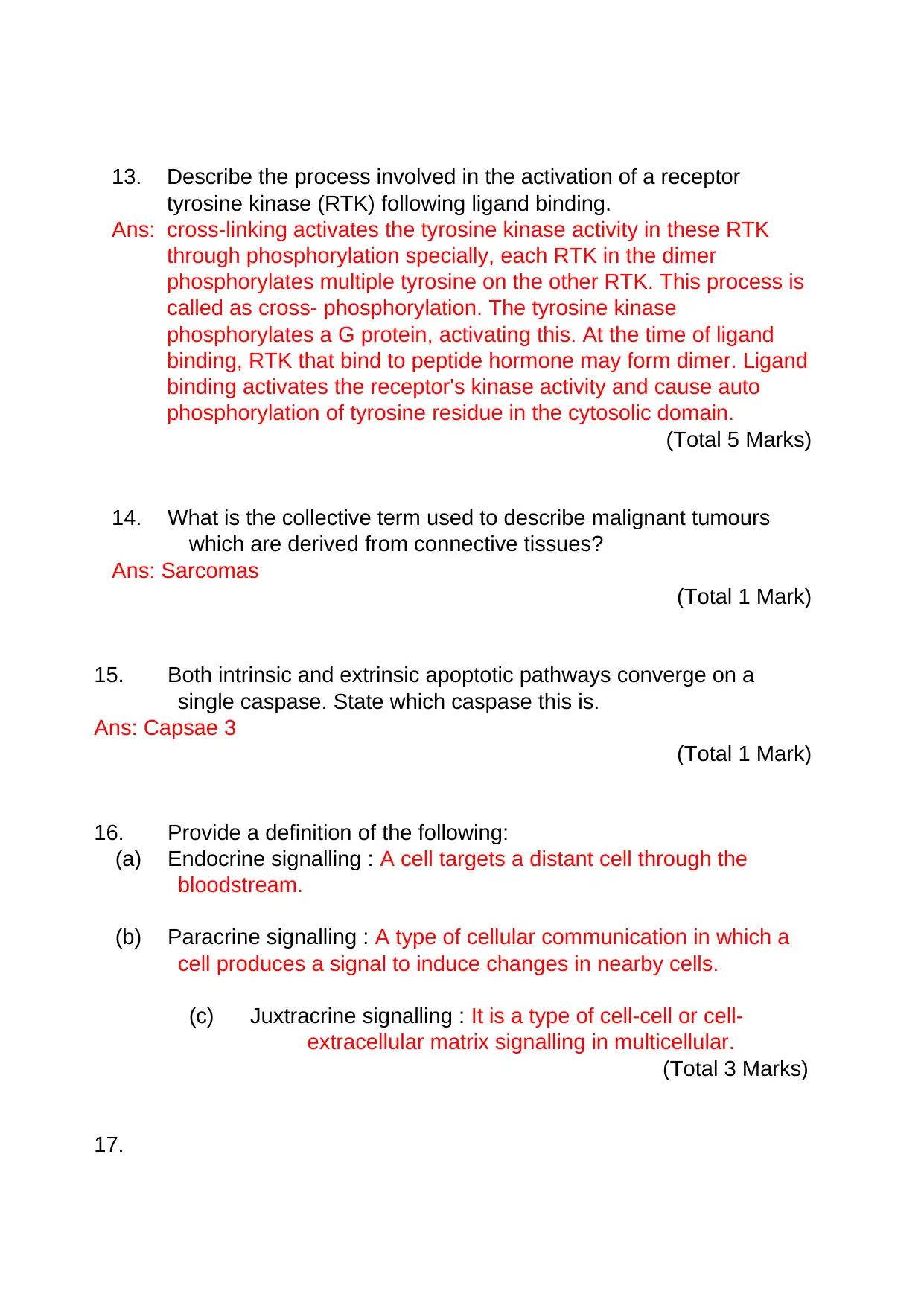
13. Describe the process involved in the activation of a receptor
tyrosine kinase (RTK) following ligand binding.
Ans: cross-linking activates the tyrosine kinase activity in these RTK
through phosphorylation specially, each RTK in the dimer
phosphorylates multiple tyrosine on the other RTK. This process is
called as cross- phosphorylation. The tyrosine kinase
phosphorylates a G protein, activating this. At the time of ligand
binding, RTK that bind to peptide hormone may form dimer. Ligand
binding activates the receptor's kinase activity and cause auto
phosphorylation of tyrosine residue in the cytosolic domain.
(Total 5 Marks)
14. What is the collective term used to describe malignant tumours
which are derived from connective tissues?
Ans: Sarcomas
(Total 1 Mark)
15. Both intrinsic and extrinsic apoptotic pathways converge on a
single caspase. State which caspase this is.
Ans: Capsae 3
(Total 1 Mark)
16. Provide a definition of the following:
(a) Endocrine signalling : A cell targets a distant cell through the
bloodstream.
(b) Paracrine signalling : A type of cellular communication in which a
cell produces a signal to induce changes in nearby cells.
(c) Juxtracrine signalling : It is a type of cell-cell or cell-
extracellular matrix signalling in multicellular.
(Total 3 Marks)
17.
tyrosine kinase (RTK) following ligand binding.
Ans: cross-linking activates the tyrosine kinase activity in these RTK
through phosphorylation specially, each RTK in the dimer
phosphorylates multiple tyrosine on the other RTK. This process is
called as cross- phosphorylation. The tyrosine kinase
phosphorylates a G protein, activating this. At the time of ligand
binding, RTK that bind to peptide hormone may form dimer. Ligand
binding activates the receptor's kinase activity and cause auto
phosphorylation of tyrosine residue in the cytosolic domain.
(Total 5 Marks)
14. What is the collective term used to describe malignant tumours
which are derived from connective tissues?
Ans: Sarcomas
(Total 1 Mark)
15. Both intrinsic and extrinsic apoptotic pathways converge on a
single caspase. State which caspase this is.
Ans: Capsae 3
(Total 1 Mark)
16. Provide a definition of the following:
(a) Endocrine signalling : A cell targets a distant cell through the
bloodstream.
(b) Paracrine signalling : A type of cellular communication in which a
cell produces a signal to induce changes in nearby cells.
(c) Juxtracrine signalling : It is a type of cell-cell or cell-
extracellular matrix signalling in multicellular.
(Total 3 Marks)
17.
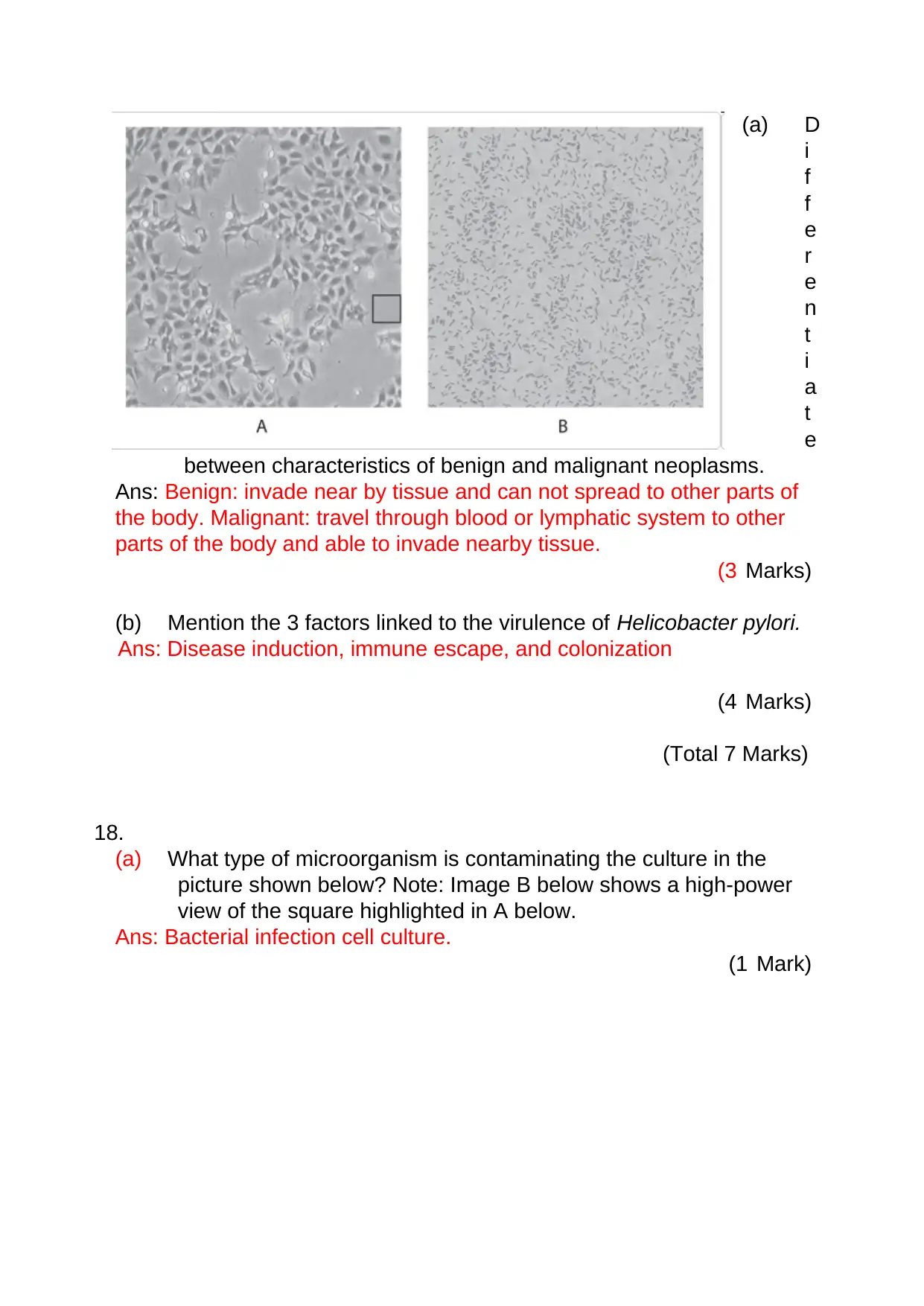
(a) D
i
f
f
e
r
e
n
t
i
a
t
e
between characteristics of benign and malignant neoplasms.
Ans: Benign: invade near by tissue and can not spread to other parts of
the body. Malignant: travel through blood or lymphatic system to other
parts of the body and able to invade nearby tissue.
(3 Marks)
(b) Mention the 3 factors linked to the virulence of Helicobacter pylori.
Ans: Disease induction, immune escape, and colonization
(4 Marks)
(Total 7 Marks)
18.
(a) What type of microorganism is contaminating the culture in the
picture shown below? Note: Image B below shows a high-power
view of the square highlighted in A below.
Ans: Bacterial infection cell culture.
(1 Mark)
i
f
f
e
r
e
n
t
i
a
t
e
between characteristics of benign and malignant neoplasms.
Ans: Benign: invade near by tissue and can not spread to other parts of
the body. Malignant: travel through blood or lymphatic system to other
parts of the body and able to invade nearby tissue.
(3 Marks)
(b) Mention the 3 factors linked to the virulence of Helicobacter pylori.
Ans: Disease induction, immune escape, and colonization
(4 Marks)
(Total 7 Marks)
18.
(a) What type of microorganism is contaminating the culture in the
picture shown below? Note: Image B below shows a high-power
view of the square highlighted in A below.
Ans: Bacterial infection cell culture.
(1 Mark)

(b) What is the nature of the contamination shown below?
Ans: Destructive nature
(1 Mark)
(c) Please identify the following micro-organisms regarding
colony formation and gram classification.
ANS: Staphylococcus aureus, gram positive bacteria
(1 Mark)
Ans: Destructive nature
(1 Mark)
(c) Please identify the following micro-organisms regarding
colony formation and gram classification.
ANS: Staphylococcus aureus, gram positive bacteria
(1 Mark)
Paraphrase This Document
Need a fresh take? Get an instant paraphrase of this document with our AI Paraphraser
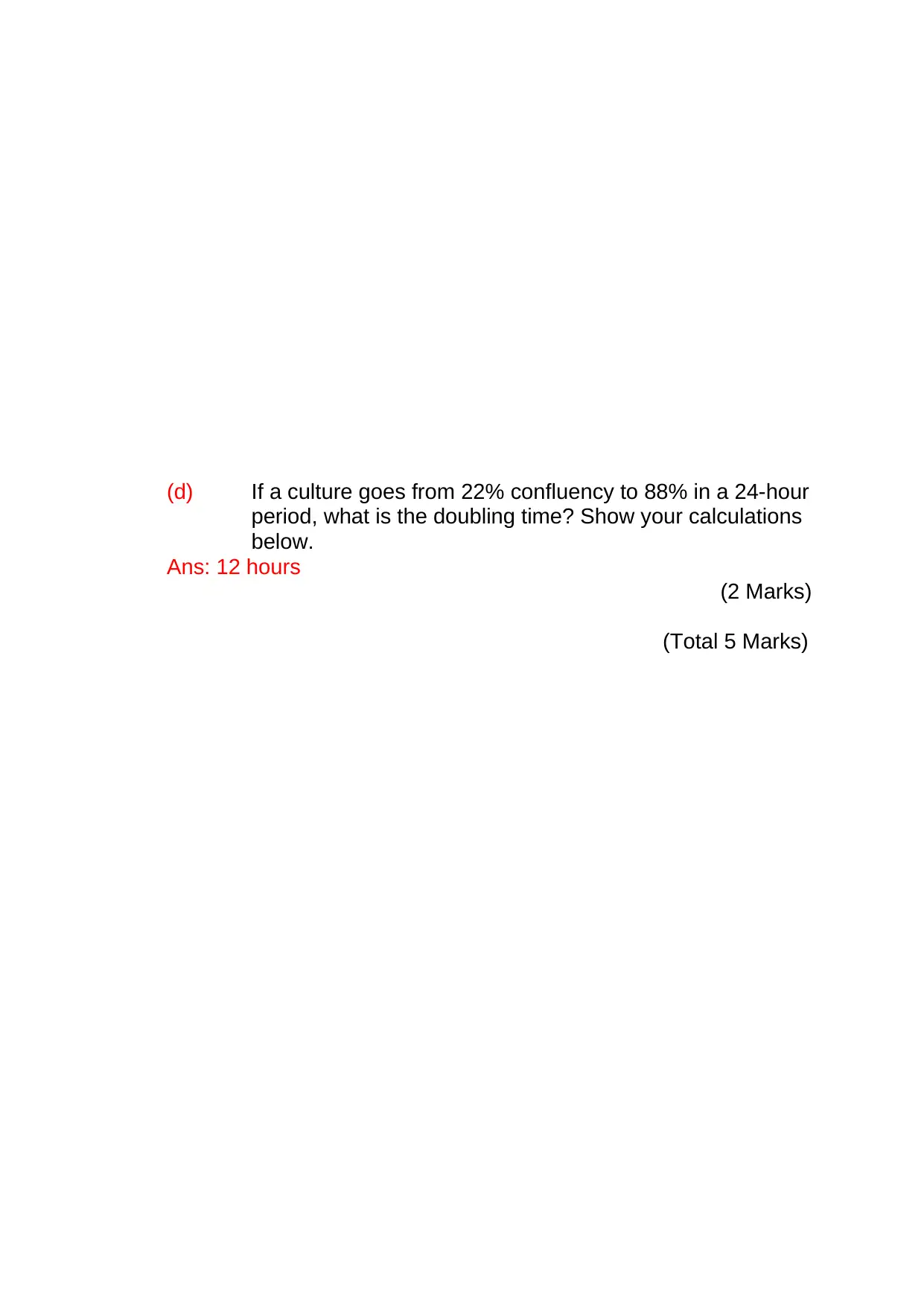
(d) If a culture goes from 22% confluency to 88% in a 24-hour
period, what is the doubling time? Show your calculations
below.
Ans: 12 hours
(2 Marks)
(Total 5 Marks)
period, what is the doubling time? Show your calculations
below.
Ans: 12 hours
(2 Marks)
(Total 5 Marks)
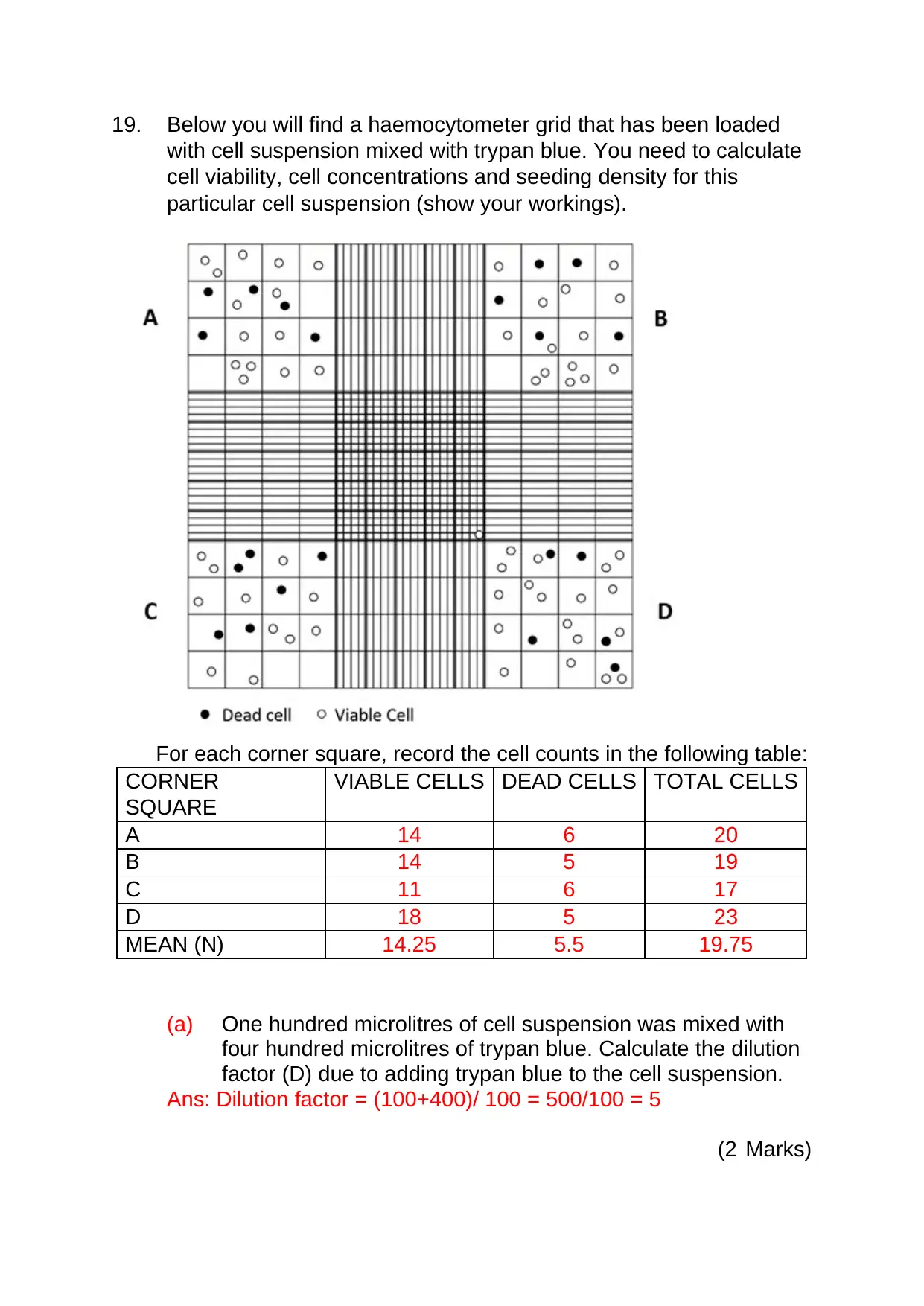
19. Below you will find a haemocytometer grid that has been loaded
with cell suspension mixed with trypan blue. You need to calculate
cell viability, cell concentrations and seeding density for this
particular cell suspension (show your workings).
For each corner square, record the cell counts in the following table:
CORNER
SQUARE
VIABLE CELLS DEAD CELLS TOTAL CELLS
A 14 6 20
B 14 5 19
C 11 6 17
D 18 5 23
MEAN (N) 14.25 5.5 19.75
(a) One hundred microlitres of cell suspension was mixed with
four hundred microlitres of trypan blue. Calculate the dilution
factor (D) due to adding trypan blue to the cell suspension.
Ans: Dilution factor = (100+400)/ 100 = 500/100 = 5
(2 Marks)
with cell suspension mixed with trypan blue. You need to calculate
cell viability, cell concentrations and seeding density for this
particular cell suspension (show your workings).
For each corner square, record the cell counts in the following table:
CORNER
SQUARE
VIABLE CELLS DEAD CELLS TOTAL CELLS
A 14 6 20
B 14 5 19
C 11 6 17
D 18 5 23
MEAN (N) 14.25 5.5 19.75
(a) One hundred microlitres of cell suspension was mixed with
four hundred microlitres of trypan blue. Calculate the dilution
factor (D) due to adding trypan blue to the cell suspension.
Ans: Dilution factor = (100+400)/ 100 = 500/100 = 5
(2 Marks)
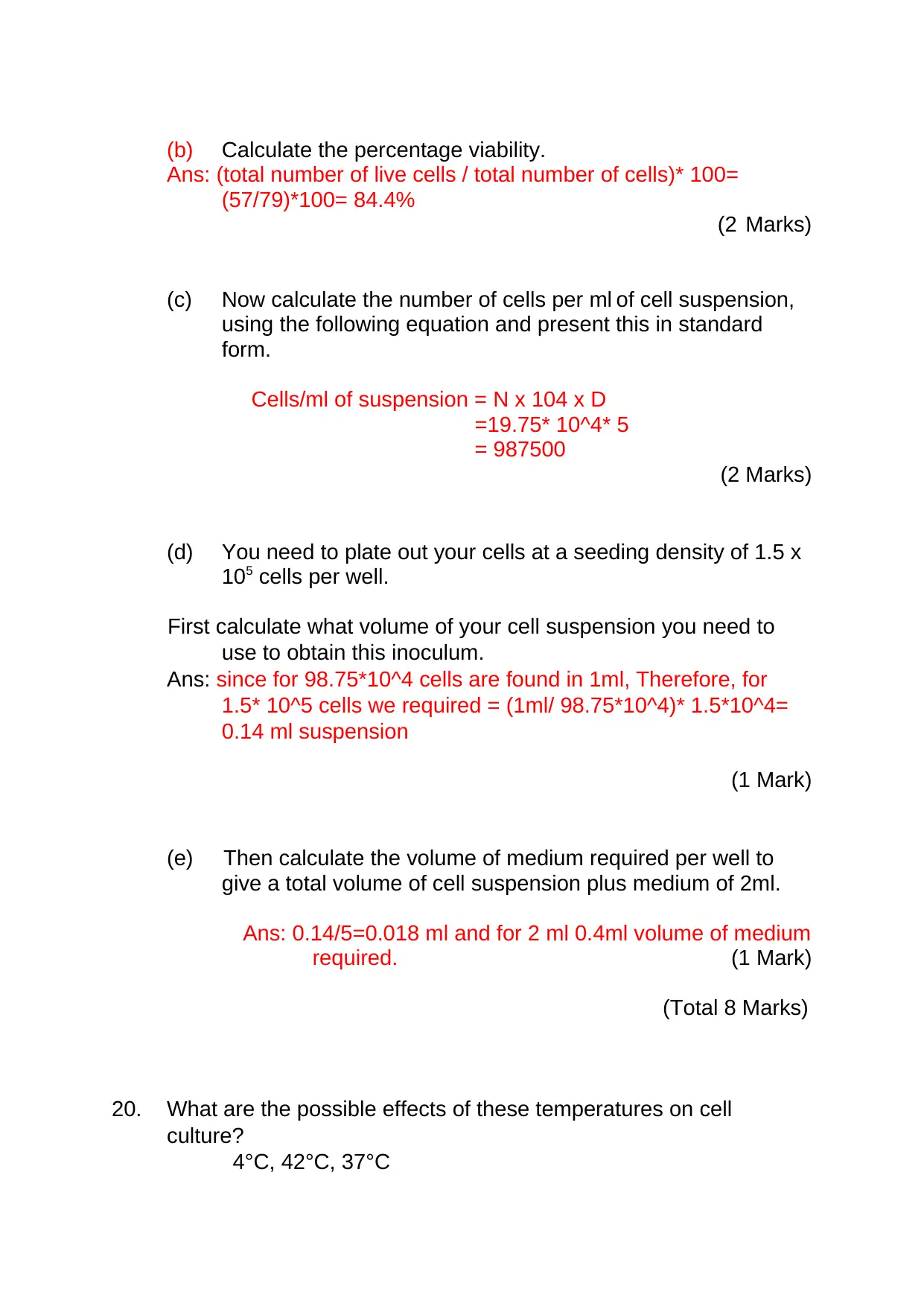
(b) Calculate the percentage viability.
Ans: (total number of live cells / total number of cells)* 100=
(57/79)*100= 84.4%
(2 Marks)
(c) Now calculate the number of cells per ml of cell suspension,
using the following equation and present this in standard
form.
Cells/ml of suspension = N x 104 x D
=19.75* 10^4* 5
= 987500
(2 Marks)
(d) You need to plate out your cells at a seeding density of 1.5 x
105 cells per well.
First calculate what volume of your cell suspension you need to
use to obtain this inoculum.
Ans: since for 98.75*10^4 cells are found in 1ml, Therefore, for
1.5* 10^5 cells we required = (1ml/ 98.75*10^4)* 1.5*10^4=
0.14 ml suspension
(1 Mark)
(e) Then calculate the volume of medium required per well to
give a total volume of cell suspension plus medium of 2ml.
Ans: 0.14/5=0.018 ml and for 2 ml 0.4ml volume of medium
required. (1 Mark)
(Total 8 Marks)
20. What are the possible effects of these temperatures on cell
culture?
4°C, 42°C, 37°C
Ans: (total number of live cells / total number of cells)* 100=
(57/79)*100= 84.4%
(2 Marks)
(c) Now calculate the number of cells per ml of cell suspension,
using the following equation and present this in standard
form.
Cells/ml of suspension = N x 104 x D
=19.75* 10^4* 5
= 987500
(2 Marks)
(d) You need to plate out your cells at a seeding density of 1.5 x
105 cells per well.
First calculate what volume of your cell suspension you need to
use to obtain this inoculum.
Ans: since for 98.75*10^4 cells are found in 1ml, Therefore, for
1.5* 10^5 cells we required = (1ml/ 98.75*10^4)* 1.5*10^4=
0.14 ml suspension
(1 Mark)
(e) Then calculate the volume of medium required per well to
give a total volume of cell suspension plus medium of 2ml.
Ans: 0.14/5=0.018 ml and for 2 ml 0.4ml volume of medium
required. (1 Mark)
(Total 8 Marks)
20. What are the possible effects of these temperatures on cell
culture?
4°C, 42°C, 37°C
Secure Best Marks with AI Grader
Need help grading? Try our AI Grader for instant feedback on your assignments.
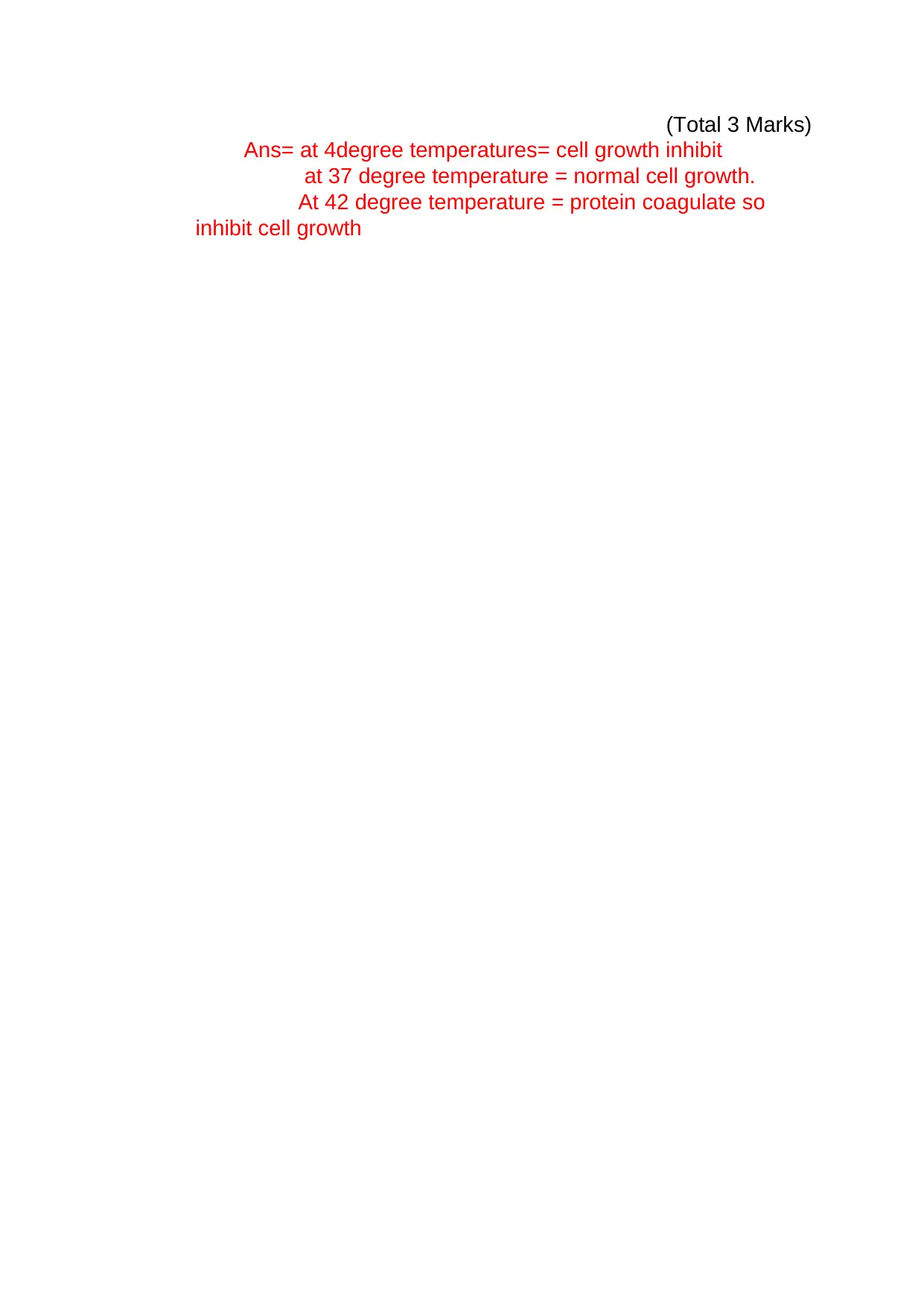
(Total 3 Marks)
Ans= at 4degree temperatures= cell growth inhibit
at 37 degree temperature = normal cell growth.
At 42 degree temperature = protein coagulate so
inhibit cell growth
Ans= at 4degree temperatures= cell growth inhibit
at 37 degree temperature = normal cell growth.
At 42 degree temperature = protein coagulate so
inhibit cell growth
1 out of 11
Your All-in-One AI-Powered Toolkit for Academic Success.
+13062052269
info@desklib.com
Available 24*7 on WhatsApp / Email
![[object Object]](/_next/static/media/star-bottom.7253800d.svg)
Unlock your academic potential
© 2024 | Zucol Services PVT LTD | All rights reserved.

